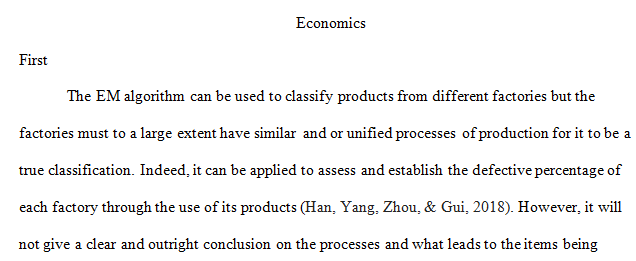
Find economic examples where the EM algorithm has been applied. Describe what was done and why.
Economics
2 pages discussion
After this write 2 reply on others discussion
about 100 words for each reply.
First Part Write 1 page
1- Find economic examples where the EM algorithm has been applied. Describe what was done and why.
2- The notion of prior and posterior distribution comes up in the analysis of economic games. Find some examples and explain their use.
Second Part Write 1 page
Urban Housing
Everyone lives in a home somewhere, whether it is permanent of temporary. What is your permanent housing like? Do you rent or own? What kind of housing would you prefer to live in? Why?
Lesson for first part
In the last module, we were introduced to some distributions which commonly occur in statistical models. But wait, we need to formally define what a statistical model is. A statistical model will turn out to be a sufficiently detailed description of what we are interested in that we can make probability statements about our data. In the end, statistical inference is all about making probability statements about our model given our assumptions and data. The degree to which our model is correct can then be probabilistically assessable. For example, consider the situation of seeing a thousand white swans. One could come to the conclusion that there are only white swans. Say, however, the 1001th swan is black. Then clearly our “white and black” conclusion (and v.v.) is incorrect. Suppose, though, instead we view each observance of a white swan a Bernoulli trial. Our original hypothesis is P(White) = 1, P(Not white) = 0. The additional information the observance of the black swan contains must force us to conclude P(White)<1 and P(Not white)>0. Now that we have a sequence of these Bernoulli trials, we now must think, given our data, what can I conclude about swans and their colour? In particular, P(White) is a parameter of interest. We will discuss prior and posterior distributions next. By prior distribution, we generally mean that we have some statistical model in mind, perhaps based on past observations of some phenomena or as a result of a hypothesis we have developed. We then acquire data and based on the data, modify our prior distribution applying Bayes Theorem. This approach underlies much of what is done in machine learning, particularly in probabilistic graphical models.
This module then introduces the concept of an estimator. We then discuss the most common technique in econometrics for developing new estimators – the maximum likelihood method. The approach uses neither a prior distribution nor any form of a loss function. The underlying idea goes something like this. We assume that the data is governed by some distribution but whose parameters are unknown. We then ask the questions, what parameter value would maximize the joint probability of the observations, that is, what parameter maximizes the likelihood of observing this particular set of observations. Although we will mostly discuss closed-form solutions, many applications use some of search to solve the problem of what parameter values make the likelihood of observing this data greatest. One technique that we will discuss and which is quite widely used is the EM algorithm. The original purpose for the EM algorithm was to impute values for missing data, but it has been used for a variety of situations in which it is suspected that data may come from two distributions. Such models are called mixture models because the data are said to be mixed by the two distributions.
Answer preview……………………………………..
 apa 360 words
apa 360 words